The Role of Artificial Intelligence in Developing the Tall Buildings of Tomorrow
Abstract
1. Introduction
1.1. Urban Challenges and the Imperative for Innovative Architectural Solutions
Artificial Intelligence’s Transformative Potential in Urban Context
1.2. Artificial Intelligence’s Transformative Potential in Architectural Construction
1.3. Research Scope and Methodological Framework for AI-Enhanced Tall Building Development
1.3.1. Research Scope
1.3.2. Research Objectives
- Investigate a brief history of TBs and their evolution, and AI accelerated development;
- Determine the main domains—design optimization, structure, energy management, construction procedures, and building operations. This is where AI can have a substantial impact on the development of skyscrapers;
- Discuss the advantages and difficulties of incorporating AI technologies into skyscraper projects and keep in mind several aspects, such as sustainability, security, affordability, and occupants’ well-being.
1.3.3. Research Questions
- RQ 1: What is the role of AI technologies in transforming skyscrapers’ design and planning processes to enhance architectural innovation and efficiency?
- RQ 2: What is the potential that AI offers to optimize construction processes and building operations throughout the lifecycle of skyscrapers?
- RQ 3: How can the integration of AI improve sustainability, energy efficiency, and occupant well-being in the skyscrapers of tomorrow?
- RQ 4: What are the key opportunities, challenges, and implications of implementing AI technologies in the development of TBs for future urban environments?
1.3.4. Research Hypothesis
1.3.5. The Significance of This Study
2. Materials and Methods
2.1. Methodology
2.2. Theoretical Background
2.2.1. Tall Buildings’ Origin, History, and Definitions
- Emporis Standards: “A multi-story structure between 35–100 m tall, or a building of unknown height from 12 to 39 floors”;
- Building code of Hyderabad, India: “A high-rise building is one with four floors or more, or 15 to 18 m or more in height”;
- The New Shorter Oxford English Dictionary: “A building having many stories”;
- International conference on fire safety in high-rise buildings: “ Any structure where the height can have a serious impact on evacuation”;
- The National Fire Protection Association, US: “A high-rise as being higher than 75 feet (23 m), or about seven stories”;
- Most buildings engineers, inspectors, architects, and similar professionals: “A high-rise is a building that is at least 75 feet (23 m)”;
2.2.2. Tall Buildings in Modern Urban Development
2.2.3. The Development of Skyscrapers
2.2.4. Why Do We Need to Build Skyscrapers?
2.2.5. AI’s Origin, History, Definitions, Types, Domains, and Applications
2.2.6. AI in Design Exploration and Image Generation
2.2.7. Natural Abstraction, Biomimicry Architecture, and Architectural Drawings
2.2.8. The Emergence of Artificial Intelligence in Architecture and Construction
- Design phase: The role of AI in this phase is enhancing space usage, energy efficiency, and structural integrity, which helps architects and engineers discover innovative, efficient designs away from traditional methods. The tools used at this phase are Autodesk Revit with Dynamo by Autodesk USA, DALL-E2 released in 2022 as the successor to DALL-E, and DALL-E3 was later released in 2023 by OpenAI USA, Midjourney multiple versions have been released (V1 through V6) by Midjourney, Inc., San Francisco, CA, USA, Hypar a cloud-based computational design platform by Hypar Inc., Culver City, CA, USA, and Wallacei, an evolutionary mutli-objective optimization engine for Grasshopper, developed by Wallacei Ltd., London, UK;
- Construction phase: AI is used in project management and on-site safety to analyze schedules, delay predictions, and resource allocation; computer vision technologies are utilized in sites’ monitoring and hazard identification. The tools used are Smartvid.io, Buildots, Scaled Robotics, and Versatile Natures, ML and IoT, enabling automated data collection, reducing human error, improving resource management, and speeding up decision-making. ML methods have also been successfully applied to predict mobile resource and equipment management trajectories [40];
- Building operation and maintenance: AI revolutionized this phase by energy optimization, early issues identification, and occupants’ experience enhancement by personalizing comfort settings, in that way reducing downtime and maintenance costs; the used tools are BuildingIQ; a cloud-based platform that uses predictive energy optimization, originally from Australia, now based in the USA, by Building IQ, Inc. (San Mateo, CA, USA) developer, Enlighted; an IoT platform for smart building management by Enlighted Inc. that now part of Siemens in Santa Clara, CA, USA, 75F; Building intelligence system focusing on HVAC optimization, by 75F developer in USA, Grid Edge; AI-driven building energy management platform, by Grid Edge, Birmingham, UK, Brainbox AI, Autonomous AI HVAC optimization system, by BrainBox AI developer, Canada, and Sidewalk Labs Mesa, Commercial building energy management platform, by Sidewalk Labs (a subsidiary of Alphabet Inc.) developer, Mountain View, CA, USA.
2.2.9. The Convergence of AI and Tall Building Development
2.2.10. Artificial Intelligence and Re-Imagination of 10 Iconic Buildings Worldwide
2.2.11. Artificial Intelligence and Smart Buildings
2.3. Analytical Approach
2.3.1. Artificial Intelligence and Skyscrapers
2.3.2. AI in Preconstruction
2.3.3. AI in Design and Construction
2.3.4. AI for Building Operations and Management
- A digital building twin
- b.
- Time Series
2.3.5. AI-Driven Environmental Controls and Environmental Impact
2.3.6. Artificial Intelligence and Sustainability—How AI Can Address Sustainability by Different Companies’ Practices?
2.3.7. The Future of Artificial Intelligence in Construction
2.3.8. Visualizing the AI-Enabled Conceptual Sustainable Skyscraper of Tomorrow
| AI Tools/ Technology | Software Example | Building Examples | Construction Phase | Primary Function | Impact Analysis and Implementation Outcomes |
|---|---|---|---|---|---|
| BIM with AI Integration | Autodesk Revit + AI, Bently SYNCHRO, Tekla Structure, Navisworks | Shanghai Tower, China, One World Center, NYC, The Shard, London. | Preconstruction Planning | Automated design optimization, clash detection, resource planning, and 4D/5D simulation. | 30–40% reduction in planning time, 25% improvement in design accuracy. Reduction in construction waste by 25% in Shanghai tower, and The Shard saw 30% faster design phase completion. |
| ML for Site Analysis | Plangrid AI, Deepsoil AI, SiteAware, Soil.ai | Jeddah Tower, KSA Taipei 101, Taiwan Dubai Creek Tower | Site Preparation | Soil analysis, environmental assessment, site logistics | 40% faster site analysis and improved ground assessment. For Taipei 101, optimization of design of foundation for seismic conditions, and for Jeddah Tower, enhanced wind load prediction. |
| Robotics and Automation | SAM (Semi- Automated Mason), WALT Robot, Boston Dynamics Spot, Dusty robotic. | Burj Khalifa, Dubai Marina Bay Sands, Singapore Lakhta Center, Russia | Construction Execution | Automated construction, material handling, and quality control | Faster construction and reduction in human error. Burj Khalifa had a 40% reduction in labor costs, and Lakhta Center achieved a 50% faster vertical assembly. |
| AI- Powered Project Management | Procore + AI, Oracle Primavera AI, BIM 360, Aconex | 30 Hudson Yards, NYC, Salesforce Tower, SF Ping An Finance Center, China | All Phases | Schedule optimization, resource allocation, and progress monitoring | Better resources are used by nearly 35%, and real-time problem-solving is also used. In Hudson Yard: 20% under budget cost. |
| Computer Vision and Drones | DroneDeploy AI, Skycatch, Percepta AIM, Open Space. | Central Park Tower, NYC Shanghai World Financial Center, Petronas Towers, Malaysia | Construction Monitoring | Progress tracking, safety monitoring, and quality inspection | Faster inspection and 80% more accurate tracking. Zero safety incidents in Central Park Tower and a 45% faster inspection cycle in Petronas. |
| Predictive Analytics | IBM Maximo, Schneider Eco-Struxure, Johnson Controls Open Blue, Siemens Enlighted | Edge Building, Amsterdam, The Tower at PNC Plaza, Capital Tower, Singapore | Operation and Maintenance | Performance prediction, energy optimization, and system monitoring | Lower maintenance costs, 30% energy savings. World’s highest BREEAM score in Edge Building, and 50% energy reduction in PNC Plaza. |
| Generative Design | Autodesk Generative Design, Grasshopper + AI, Rhino + Neural Nets, TestFit | Beijing Daxing Airport, Louvre Abu Dhabi, KAFD Tower, KSA | Design Phase | Farm optimization, Structural efficiency, and Space Planning | 50% more design alternatives and 40% material optimization, Material reduction in Beijing Daxing by 20%, and better performance in KAFD Tower, KSA |
| Digital Twin Integration | Bently I Twin, Cityzenith SmartWorld, Unity Reflect, Azure Digital Twins | Kingdom Tower, Jeddah Hudson Yards, NYC Marina Bay Sands 2 | Lifecycle Management | Time monitoring, predictive maintenance, and performance optimization | 55% operational efficiency and 35% maintenance cost reduction. Complete digital ecosystem in Hudson Yards and smart building integration in Marina Bay Sands. |
| Type of High-Rise Building | Functional Requirements | User Groups | Operational Modes | AI Applications | Construction Phases | AI Tools Used |
|---|---|---|---|---|---|---|
| Residential towers | EE, security, comfort and convenience | Residents, property managers | -24/7 varying occupancy patterns |
|
|
|
| Commercial skyscrapers |
|
|
|
|
|
|
| Mixed-use developments |
|
|
|
|
|
|
| Hospitality towers (hotels) |
|
|
|
|
|
|
2.3.9. Harnessing AI: Transformative Applications Across Diverse Skyscraper Functions
2.3.10. Constraints of Conceptual Designs Produced by AI
2.3.11. Tall Building Aging—Adaptation with AI Continuous Evolution
2.3.12. Bridging Culture and Technology: AI and Culturally Sensitive Architecture
2.3.13. Impact of Climate on AI in Architecture and Construction
2.3.14. AI Applications in Energy-Efficient Renovation for Existing Skyscrapers
2.3.15. Constraints and Applications of AI Tools in Architecture and Construction
2.3.16. Will AI Stifle Human Creativity or Catalyze It?
2.4. Comparative Analysis
3. Results
4. Discussion
4.1. Linking the Research Questions to the Study’s Findings
- RQ 1: What is the role of AI technologies in transforming skyscrapers’ design and planning processes to enhance architectural innovation and efficiency?
- RQ 2: What is the potential that AI offers to optimize construction processes and building operations throughout the lifecycle of skyscrapers?
- RQ 3: How can the integration of AI improve sustainability, energy efficiency, and occupant well-being in the skyscrapers of tomorrow?
- RQ 4: What are the key opportunities, challenges, and implications of implementing AI technologies in the development of TBs for future urban environments?
4.2. Recommendation for Key Future Research Directions
- Formulate all-encompassing frameworks for AI applications in skyscraper design;
- Inquire into the ethical and regulatory ramifications of AI within the field of architecture;
- Tackle the establishment of standardized metrics for the assessment of AI efficacy in building design;
- Assess the conception of interdisciplinary methodologies that merge AI with architectural proficiency.
4.3. Research Findings and Future Direction for Various Stakeholders
5. Conclusions
Author Contributions
Funding
Data Availability Statement
Conflicts of Interest
References
- Builtin. Available online: https://builtin.com/artificial-intelligence/artificial-intelligence-future (accessed on 16 December 2024).
- Al-Kodmany, K.; Xue, Q.; Sun, C. Reconfiguring Vertical Urbanism: The Example of Tall Buildings and Transit-Oriented Development (TB-TOD) in Hong Kong. Buildings 2022, 12, 197. [Google Scholar] [CrossRef]
- Almaz, A.; El-Agouz, E.; Abdelfatah, M.; Mohamed, I. The Future Role of Artificial Intelligence (AI) Design’s Integration into Architectural and Interior Design Education is to Improve Efficiency, Sustainability, and Creativity. J. Archit. Civ. Eng. 2024, 12, 1749–1772. [Google Scholar] [CrossRef]
- Skyscrapercenter. Available online: https://www.skyscrapercenter.com/company/18477 (accessed on 1 December 2024).
- Kazeem, K.; Olawumi, T.; Osunsanmi, T. Roles of Artificial Intelligence and Machine Learning in Enhancing Construction Processes and Sustainable Communities. Buildings 2023, 13, 2061. [Google Scholar] [CrossRef]
- Sisson, A.; McGuirk, P.; Dowling, R.; Baker, T.; Maalsen, S. Innovating urban governance through ‘Challenges’. J. Urban Aff. 2023, 1–17. [Google Scholar] [CrossRef]
- United Nations. Challenges and Way Forward in the Urban Sector Sustainable Development in the 21st Century (SD21). Available online: https://www.un.org/esa/dsd/dsd_sd21st/21_pdf/challenges_and_way_forward_in_the_urban_sector_web.pdf (accessed on 16 December 2024).
- Pesce, B.; Bagaini, A. Urban and Architectural Adaptive Strategies for Inclusive Cities: A Review of International Innovation Experiments. plaNext 2019, 9, 65–82. [Google Scholar] [CrossRef] [PubMed]
- Yan, Y.; Li, D.; Qin, K.; Kong, Y.; Wu, X.; Liu, Q. Sustainable Urbanism and Architectural Design: An Interdisciplinary Exploration. In Proceedings of the 3rd International Conference on Urban Planning and Regional Economy (UPRE 2024), Bangkok, Thailand, 22–24 April 2024; p. 4. Available online: https://www.shs-conferences.org/articles/shsconf/pdf/2024/12/shsconf_upre2024_01015.pdf (accessed on 29 January 2025).
- Canedo, V.; Fernandez, L.; Cancela, B.; Betanzos, A. A review of green artificial intelligence: Towards a more sustainable future. Neurocomputing 2024, 599, 128096. [Google Scholar] [CrossRef]
- Zhong, Y.; Zhong, Y.; Zhang, L.; Tang, Z. The Path to Urban Sustainability: Urban Intelligent Transformation and Green Development—Evidence from 286 Cities in China. Sustainability 2024, 16, 10394. [Google Scholar] [CrossRef]
- Wang, J.; Zhang, Y. Machine Learning in Urban Planning: A Review. Urban Plan. 2021, 6, 1–12. [Google Scholar]
- Mehmood, R.; Yigitcanlar, T.; Corchado, J. Smart Technologies for Sustainable Urban and Regional Development. Sustainability 2024, 16, 1171. [Google Scholar] [CrossRef]
- Omer, A.; Salih, S. Urban Infrastructure and AI: A New Paradigm for Resource Management”. Int. J. Urban Sci. 2023, 27, 74–95. [Google Scholar]
- Autodesk. Available online: https://www.autodesk.com/design-make/articles/ai-in-architecture (accessed on 8 December 2024).
- Khan, A.; Bello, A.; Arqam, M.; Ullah, F. Integrating Building Information Modelling and Artificial Intelligence in Construction Projects: A Review of Challenges and Mitigation Strategies. Technologies 2024, 12, 185. [Google Scholar] [CrossRef]
- Nationthailand. Available online: https://www.nationthailand.com/blogs/news/general/40044157 (accessed on 18 December 2024).
- Ekici, B.; Kazanasmaz, T.; Turrin, M.; Tasgetiren, M. Multi-zone optimisation of high-rise buildings using artificial intelligence for sustainable metropolises. Part 1: Background, methodology, setup, and machine learning results. Sol. Energy 2021, 224, 373–389. [Google Scholar] [CrossRef]
- Al-Kodmany, A. The Future of the City, Tall Buildings and Urban Design; WIT Press: Chicago, IL, USA, 2013; Available online: https://books.google.com.eg/books?hl=ar&lr=&id=yBPA9kYZXTMC&oi=fnd&pg=PP1&ots=RU-BpHYb6p&sig=AsD_VE5IxNGSHFPdyG_AbQz_TzI&redir_esc=y#v=onepage&q&f=false (accessed on 20 November 2024).
- CTBUH. CTBUH Height Criteria for Measuring & Defining Tall Buildings. Available online: https://cloud.ctbuh.org/CTBUH_HeightCriteria.pdf (accessed on 5 May 2024).
- Constrofacilitator. Available online: https://constrofacilitator.com/high-rise-building-an-analysis-of-development-types-and-importance/ (accessed on 20 June 2024).
- ThoughtCo. Available online: https://www.thoughtco.com/how-skyscrapers-became-possible-1991649 (accessed on 5 May 2024).
- ThoughtCo. Available online: https://www.thoughtco.com/form-follows-function-177237 (accessed on 5 May 2024).
- Al-Kodmany, K. Sustainable Skyscrapers: A Review of Green Features. Int. J. Archit. Eng. Technol. 2021, 8, 37–51. [Google Scholar] [CrossRef]
- Illustrarch. Available online: https://illustrarch.com/articles/15458-the-evolution-of-skyscraper-architecture.html (accessed on 20 August 2024).
- Skyscrapercenter. Available online: https://www.skyscrapercenter.com/buildings?status=completed&material=all&function=all&location=world&year=2024%60 (accessed on 2 February 2025).
- Vijayasree, A. A Study of Challenges in Designing and Construction of Skyscrapers. Int. J. Eng. Res. Technol. 2019, 8, 372–391. Available online: https://www.ijert.org/research/a-study-of-challenges-in-designing-and-construction-of-skyscrapers-IJERTV8IS120201.pdf (accessed on 3 December 2024). [CrossRef]
- Planradar. Available online: https://www.planradar.com/gb/skyscrapers-city-image/ (accessed on 12 April 2024).
- Constructconnect. Available online: https://www.constructconnect.com/blog/ai-in-construction-has-landed (accessed on 2 October 2024).
- Ghosh, M.; Thirugnanam, A. Introduction to Artificial Intelligence. In Artificial Intelligence for Information Management: A Healthcare Perspective; Springer Nature: Singapore, 2021; pp. 23–44. [Google Scholar] [CrossRef]
- Hello Future. Available online: https://hellofuture.orange.com/en/interactive/artificial-intelligence-hopes-fears-humankind#a-brief-history-of-ai (accessed on 16 October 2024).
- Matter, N.; Gado, N. Artificial Intelligence in Architecture: Integration into Architectural Design Process. J. Eng. Res. 2024, 181, 1–16. [Google Scholar] [CrossRef]
- Novelai. Available online: https://novelai.net/ (accessed on 19 February 2025).
- Stability.ai. Available online: https://stability.ai/stable-image (accessed on 19 February 2025).
- Open.ai. Available online: https://openai.com/index/dall-e-3/ (accessed on 19 February 2025).
- Midjourney-v6. Available online: https://www.midjourney-v6.com/ (accessed on 19 February 2025).
- Bao, Y.; Xiang, C. Exploration of Conceptual Design Generation Based on the Deep Learning Model—Discussing the Application of AI Generator to the Preliminary Architectural Design Process. In Proceedings of the Creativity in the Age of Digital Reproduction; Springer: Singapore, 2024; pp. 171–178. [Google Scholar] [CrossRef]
- Leach, N. Architecture in the Age of Artificial Intelligence: An introduction to AI for architects, 1st ed.; Bloomsbury Visual Art: London, UK, 2021. [Google Scholar] [CrossRef]
- Dezeen. Available online: https://www.dezeen.com/2022/11/16/ai-design-architecture-product/ (accessed on 28 January 2025).
- Campo, M.; Carlson, A.; Manninger, S. Towards Hallucinating Machines Designing with Computational Vision. Int. J. Archit. Comput. 2021, 19, 88–103. [Google Scholar] [CrossRef]
- Hegazy, M.; Saleh, A. Evolution of AI role in architectural design: Between parametric exploration and machine hallucination. MSA Eng. J. 2023, 2, 1–26. Available online: https://msaeng.journals.ekb.eg/article_291873_9e9b36545c240184708f6506df34ab31.pdf (accessed on 15 November 2024). [CrossRef]
- Muntañola, J. Artificial intelligence and Architectural Design: An introduction, 1st ed.; Iniciativa Digital Politècnica, Oficina de Publicacions Acadèmiques Digitals de la UPC: Barcelona, Spain, 2022; pp. 17–21. Available online: https://upcommons.upc.edu/handle/2117/372903 (accessed on 9 November 2024).
- Na, S.; Heo, S.; Choi, W.; Kim, C.; Whang, S. Artificial Intelligence (AI)—Based Technology Adoption in the Construction Industry: A Cross National Perspective Using the Technology Acceptance Model. Buildings 2023, 13, 2518. [Google Scholar] [CrossRef]
- Noori, F.; Yashoaa, N. Dynamo—Grasshopper Dictionary Guidelines for Beginners, 1st ed.; Independent Publisher: Chicago, IL, USA, 2023; Available online: https://dynamobim.org/the-use-of-imagination-and-ai-for-high-rise-buildings-made-with-dynamo/ (accessed on 30 August 2024).
- AI reimagines 10 iconic buildings around the world, Architectural Digest. Available online: https://www.architecturaldigest.in/story/ai-gives-dystopian-makeovers-to-10-iconic-buildings-around-the-world/ (accessed on 10 October 2024).
- Farzaneh, H.; Malehmirchegini, L.; Bejan, A.; Afolabi, T.; Mulumba, A.; Daka, P. Artificial Intelligence Evolution in Smart Buildings for Energy Efficiency. Appl. Sci. 2021, 11, 763. [Google Scholar] [CrossRef]
- Sangole, T. Use of AI on Renovated Existing Buildings. Int. Eng. J. Res. Dev. 2018, 3, 1–10. [Google Scholar] [CrossRef]
- Zhou, Q.; Li, Q.; Lu, B. Displacement estimation for a high-rise building during Super Typhoon Mangkhut based on field measurements and machine learning. Eng. Stru. 2024, 307, 117947. [Google Scholar] [CrossRef]
- Khajavi, S.; Motlagh, N.; Jaribion, A.; Werner, L.; Holmstrom, J. Digital Twin: Vision, Benefits, Boundaries, and Creation for Buildings. IEEE Access 2019, 7, 147406–147419. [Google Scholar] [CrossRef]
- Examples of Artificial Intelligence in Construction: How AI is Revolutionizing Efficiency. Downtobid. Available online: https://downtobid.com/blog/examples-of-artificial-intelligence-in-construction (accessed on 15 October 2024).
- Yang, L.; Allen, G.; Zhang, Z.; Zhao, Y. Achieving On-Site Trustworthy AI Implementation in the Construction Industry: A Framework Across the AI Lifecycle. Buildings 2025, 15, 21. [Google Scholar] [CrossRef]
- Designboom. Midjourney Envisions a Futuristic Sustainable City with Air-Purifying Biophilic Skyscrapers. Available online: https://www.designboom.com/architecture/ai-futuristic-sustainable-city-air-purifying-biophilic-skyscrapers-manas-bhatia-08-22-2022/ (accessed on 20 November 2024).
- Bosch. Smart Building: Artificial Intelligence in Building Management. Available online: https://www.boschbuildingsolutions.com/xc/en/news-and-stories/smart-buildings/artificial-intelligence-in-building-management/ (accessed on 15 October 2024).
- Chisom, O.; Biu, P.; Umoh, A.; Obaedo, B.; Adegbite, A.; Abatan, A. Reviewing the role of AI in environmental monitoring and conservation: A data-driven revolution for our planet. World J. Adv. Res. Rev. 2024, 21, 161–171. [Google Scholar] [CrossRef]
- Saleh, S.; Battseren, B. AI-driven Solutions for Sustainable Environment Monitoring Embedded Self organising Systems. Embed. Selforganising Syst. 2023, 10, 1–2. [Google Scholar] [CrossRef]
- Emre, H. Space Efficiency in Tapered Super-Tall Towers. Buildings 2023, 13, 2819. [Google Scholar] [CrossRef]
- Regona, M.; Yigitcanlar, T.; Hon, C.; Teo, M. Artificial intelligence and sustainable development goals: Systematic literature review of the construction industry. Sustain. Cities Soc. 2024, 108, 105499. [Google Scholar] [CrossRef]
- Autodesk. Available online: https://www.autodesk.com/solutions/generative-design (accessed on 18 October 2024).
- KPF. About SUSTAINABILITY. Available online: https://www.kpf.com/what-we-do/sustainability/ (accessed on 19 November 2024).
- SCRIBD. The Future of Construction. Available online: https://www.scribd.com/document/396959551/The-Future-of-Construction (accessed on 19 November 2024).
- Chen, H.; Ying, K. Artificial Intelligence in the Construction Industry: Main Development Trajectories and Future Outlook. Appl. Sci. 2022, 12, 5832. [Google Scholar] [CrossRef]
- Li, J.; Liu, Z.; Han, G.; Demian, P.; Osmani, M. The Relationship Between Artificial Intelligence (AI) and Building Information Modeling (BIM) Technologies for Sustainable Building in the Context of Smart Cities. Sustainability 2024, 16, 10848. [Google Scholar] [CrossRef]
- Pena, M.; Carballal, A.; Fernandez, N.; Santos, I.; Romero, J. Artificial intelligence applied to conceptual design. A review of its use in architecture. Autom. Constr. 2021, 124, 103550. [Google Scholar] [CrossRef]
- Pasupuleti, R.; Orekanti, E.; Rao, B. Building Tomorrow: Navigating Sustainable Construction with Artificial Intelligence. In Proceedings of the International Conference on Social and Sustainable Innovations in Technology and Engineering (SASI-ITE), Tadepalligudem, India, 23–25 February 2024; pp. 125–130. [Google Scholar] [CrossRef]
- Ivanova, S.; Kuznetsov, A.; Zverev, R.; Rada, A. Artificial Intelligence Methods for the Construction and Management of Buildings. Sensors 2023, 23, 8740. [Google Scholar] [CrossRef]
- Abioye, S.; Oyedele, L.; Akanbi, L.; Ajayi, A.; Delgado, J.; Bilal, M.; Akinade, O.; Ahmed, A. Artificial intelligence in the construction industry: A review of present status, opportunities and future challenges. J. Build. Eng 2021, 44, 103299. [Google Scholar] [CrossRef]
- Enjellina; Beyan, E.; Rossy, A. A Review of AI Image Generator: Influence, Challenges, and Future Prospects for Architectural Field. J. Artif. Intell. Archit. 2023, 2, 53–65. Available online: https://ojs.uajy.ac.id/index.php/JARINA/article/view/6662/2893 (accessed on 5 November 2024).
- Olszewski, D.; Huber, G. The role of artificial intelligence in intelligent operational management of commercial buildings. Buildings 2021, 11, 40. [Google Scholar] [CrossRef]
- CJR Builds Hero. The Future of Mixed-Use Developments: Innovations and Trends. Available online: https://cjrbuilds.com/the-future-of-mixed-use-developments-innovations-and-trends/ (accessed on 16 February 2025).
- Alanne, K.; Sierla, S. An overview of machine learning applications for smart buildings. Autom. Constr. 2022, 76, 103628. [Google Scholar] [CrossRef]
- THE TOWER INFO. Dubai Creek Tower Facts and Information. Available online: https://thetowerinfo.com/buildings-list/dubai-creek-tower/ (accessed on 16 October 2024).
- Chan, S.; Hannum, J.; Logan, W.; Vaish, M. The Skyscraper of the Future: Integrating a Flexible Program With Energy Innovation. In Proceedings of the Emerging trends in Global Interchanges: Resurgence of the Skyscraper City, New York, NY, USA, 26–27 October 2015; Available online: https://global.ctbuh.org/resources/papers/download/2498-the-skyscraper-of-the-future-integrating-a-flexible-program-with-energy-innovation.pdf (accessed on 27 November 2024).
- Ray, P.; Roy, S. Skyscrapers: Origin, History, Evolution and Future. J. Today’s Ideas Tomorrow’s Technol. 2018, 6, 9–20. Available online: https://www.researchgate.net/publication/333894369_Skyscrapers_Origin_History_Evolution_and_Future#full-text#full-text (accessed on 4 December 2024).
- Aldoseri, A.; AL-Khalifa, K.; Hamouda, A. Re-Thinking Data Strategy and Integration for Artificial Intelligence: Concepts, Opportunities and Challenges. Appl. Sci. 2023, 12, 7082. [Google Scholar] [CrossRef]
- Hua, H.; Li, Y.; Dong, N.; Wang, T.; Cao, J.; Li, W. Edge Computing with Artificial Intelligence: A Machine Learning Perspective. ACM Comput. Surv. 2023, 55, 1–35. [Google Scholar] [CrossRef]
- Sharma, N.; Chand, R.; Buksh, Z.; Ali, A.; Hanif, A.; Beheshti, A. Explainable AI Frameworks: Navigating the Present Challenges and Unveiling Innovative Applications. Algorithms 2024, 17, 227. [Google Scholar] [CrossRef]
- Mai, T.; Nguyen, M.; Ghobakhlou, A.; Yan, W.; Chhun, B.; Nguyen, H. Decoding a decade: The evolution of artificial intelligence in security, communication, and maintenance within the construction industry. Automate. Constr. 2024, 165, 105522. Available online: https://www.sciencedirect.com/science/article/pii/S0926580524002589 (accessed on 26 January 2025). [CrossRef]
- Zhavorankov, A.; Mamoshina, P.; Vanhaelen, Q.; Knudsen, M.; Moskalev, A.; Alper, A. Artificial intelligence for aging and longevity research: Recent advances and perspectives. Ageing Res. Rev. 2019, 49, 49–66. [Google Scholar] [CrossRef] [PubMed]
- Al-Haroun, Y. The Impact of Artificial Intelligence on Architectural Design, Identity, and Culture-Making in Kuwait and the Gulf. TDSR 2024, 1, 71–82. Available online: https://www.researchgate.net/publication/385896314_The_Impact_of_Artificial_Intelligence_on_Architectural_Design_Identity_and_Culture-Making_in_Kuwait_and_the_Gulf (accessed on 24 January 2025).
- Mehraban, M.; Alnaser, A.; Sepasgozar, S. Building Information Modeling and AI Algorithms for Optimizing Energy Performance in Hot Climates: A Comparative Study of Riyadh and Dubai. Buildings 2024, 14, 2748. [Google Scholar] [CrossRef]
- Garcia, A.; Sobeida, J.; Choez, M.; Heredia, L.; Loor, A.; Carazas, R.; Solis, E. Prediction of temperature and relative humidity with AI on the Ecuadorian cost. Heritage Sustain. Dev. 2024, 6, 671–688. [Google Scholar] [CrossRef]
- Ghahramani, A.; Galicia, P.; Lehrer, D.; Varghese, Z.; Wang, Z.; Pandit, Y. Artificial Intelligence for Efficient Thermal Comfort Systems: Requirements, Current Applications and Future Directions. Front. Built Environ. 2020, 6, 49. Available online: https://www.frontiersin.org/journals/built-environment/articles/10.3389/fbuil.2020.00049/full (accessed on 10 February 2025). [CrossRef]
- Sun, L.; Ji, G. Machine Learning for Real-Time Building Outdoor Wind Environment Prediction Framework in Preliminary Design: Taking Xinjiekou Area of Nanjing, China as the Case. Buildings 2024, 14, 2613. [Google Scholar] [CrossRef]
- OrbitalStack. How Predictive AI Is Revolutionizing Building Design. Available online: https://orbitalstack.com/how-predictive-ai-is-revolutionizing-building-design/ (accessed on 27 January 2025).
- Motawa, I.; Almarshad, A. A knowledge-based BIM system for building maintenance. Automate Constr. 2013, 29, 173–182. [Google Scholar] [CrossRef]
- Bocaneala, N.; Mayouf, M.; Vakaj, E.; Shelbourn, M. Artificial Intelligence Based Methods for Retrofit Projects: A Review of Applications and Impacts. Arch. Comput. Methods Eng. 2024, 31, 1–28. [Google Scholar] [CrossRef]
- Seraj, H.; Jahromi, A.; Amirkhani, S. Developing a Data-Driven AI Model to Enhance Energy Efficiency in UK Residential Buildings. Sustainability 2024, 16, 3151. [Google Scholar] [CrossRef]
- Amasyali, K.; El-Gohary, M. A review of data-driven building energy consumption prediction techniques. Renewable and Sustainable Energy Reviews. Renew. Sust. Energ. 2018, 81, 1192–1205. [Google Scholar] [CrossRef]
- Garbett, J.; Hartley, T.; Heesom, D. A multi-user collaborative BIM-AR system to support design and construction. Autom, Constr. 2021, 122, 103487. [Google Scholar] [CrossRef]
- Baker, S.; Kauffman, J. Ethical considerations in the use of artificial intelligence in architecture. JAE 2020, 74, 45–58. [Google Scholar]
- Gonzalez, R. Cultural considerations in architectural design: Analyzing the effects of AI on cultural representation. Arch. Edu. 2019, 73, 60–68. [Google Scholar]
- Shorten, C.; Khoshgoftaar, T. A survey on image data augmentation for deep learning. Big Data 2019, 6, 60. Available online: https://journalofbigdata.springeropen.com/articles/10.1186/s40537-019-0197-0 (accessed on 11 February 2025). [CrossRef]
- Northwestern-MEDILL. Artificial Intelligence and the Future of Work: Expert Shares How AI Will Become a Tool to Aid Creativity. Available online: https://www.medill.northwestern.edu/news/2018/artificial-intelligence-expert-kai-fu-lee-visits-medill-imc.html (accessed on 3 February 2025).
- Kapoor, H.; Kaufman, J. Creativity and Morality; Academic Press: London, UK, 2022; Available online: https://www.researchgate.net/profile/Kat-Schrier/publication/368898661_Book_-_Creativity_and_Morality/links/63ffebc00cf1030a56619864/Book-Creativity-and-Morality.pdf (accessed on 11 February 2025).
- Shtefan, A. Creativity and artificial intelligence: A view from the perspective of copyright. J. Intellect. Prop. Law Pr. 2021, 16, 720–728. [Google Scholar] [CrossRef]
- Toptal Designers. The Present and Future of AI in Design (With Infographic). Available online: https://www.toptal.com/designers/product-design/infographic-ai-in-design (accessed on 16 February 2025).
- Forty, A. Words and Buildings: A Vocabulary of Modern Architecture; Thames & Hudson Ltd.: London, UK, 2000; Available online: https://dash1.we822w5sd.sbs/Words_And_Buildings_A_Vocabulary_Of_Modern_Architecture.zip?c=AJocsWdKbgUAXFgCAEVHFwASAAAAAABK (accessed on 11 February 2025).
- Bolek, B.; Tutal, O.; Ozbasaran, H. A systematic review on artificial intelligence applications in architecture. DR Arch. 2023, 4, 91–104. [Google Scholar] [CrossRef]
- Muniandi, B.; Maurya, P.; Bhavani, C.; Kulkarni, S.; Yellu, R.; Chauhan, N. AI-Driven Energy Management Systems for Smart Buildings. Power Syst. Technol. 2024, 48, 322–337. [Google Scholar] [CrossRef]
- Parametric Architecture. AI-Enhanced Materials: Driving Sustainability in Modern Architecture. Available online: https://parametric-architecture.com/ai-enhanced-materials-driving-sustainability/?srsltid=AfmBOoqQi05mk9FFapBKKQGdcslqIE44f_xCHsSLjNwse9Dwfp8DW2i0 (accessed on 3 February 2025).
- Chen, L. Artificial intelligence for calculating and predicting building carbon emissions: A review. Enviro. Chemist. Lett. 2024, 10311, 1799. [Google Scholar]
- The Edge Amsterdam, The Netherlands. PLP Architecture. Available online: https://www.plparchitecture.com/ (accessed on 3 February 2025).
- ESBYNC. The Empire State Building. Available online: https://www.esbnyc.com/ (accessed on 3 February 2025).
- Li, Y.; Chen, H.; Yu, P.; Yang, L. A Review of Artificial Intelligence in Enhancing Architectural Design Efficiency. Appl. Sci. 2025, 15, 1476. [Google Scholar] [CrossRef]
- Gado, N. AI Revolutionizes Construction Management Building Smarter, Safer, and Efficiently Addressing Industry Challenges. J. Eng. Res. 2024, 183, 330–344. Available online: https://erj.journals.ekb.eg/article_376597_e0bae8c80d1cd7df9bc8b1c9369d52c6.pdf (accessed on 9 February 2025). [CrossRef]
- Cecconi, F.R.; Khodabakhshian, A.; Rampini, L. Building Tomorrow: Unleashing the Potential of Artificial Intelligence in Construction; Springer: Cham, Switzerland, 2025. [Google Scholar] [CrossRef]
- BUILD UP, Construction industry: What to expect in 2025, The European Commission. Available online: https://build-up.ec.europa.eu/en/news-and-events/news/construction-industry-what-expect-2025 (accessed on 17 February 2025).
- Seyedzadeh, S.; Rahimian, F.; Glesk, I.; Roper, M. Machine learning for estimation of building energy consumption and performance: A review. Vis. Eng. 2018, 6, 5. [Google Scholar] [CrossRef]
- Yayla, A.; Swierczewska, K.; Kaya, M.; Karaca, B. Artificial Intelligence (AI)-Based Occupant-Centric Heating Ventilation and Air Conditioning (HVAC) Control System for Multi-Zone Commercial Buildings. Sustainability 2022, 14, 16107. [Google Scholar] [CrossRef]
- Zhou, Y.; Herr, C.M.; Tsou, J.Y. AI-Based Models in Support of Human-Centric Indoor Environment Design: Towards Climate-Adaptive Façade Design Integrating Occupant Satisfaction. In Towards a Carbon Neutral Future; Papadikis, K., Zhang, C., Tang, S., Liu, E., Di Sarno, L., Eds.; ICSBS 2023. Lecture Notes in Civil Engineering; Springer: Singapore, 2024; Volume 393. [Google Scholar] [CrossRef]
- Baduge, S.; Thilakarathna, S.; Perera, J.; Arashpour, M.; Sharafi, P.; Teodosio, B.; Shringi, A.; Mendis, P. Artificial intelligence and smart vision for building and construction 4.0: Machine and deep learning methods and applications. Autom. Constr. 2022, 141, 104440. [Google Scholar] [CrossRef]
- Mehmood, M.; Chun, D.; Zeeshan, H.H.; Jeon, G.; Chen, K. A review of the applications of artificial intelligence and big data to buildings for energy-efficiency and a comfortable indoor living environment. Energy Build. 2019, 202, 109383. [Google Scholar] [CrossRef]
- Adebowale, O.; Agumba, J. Artificial Intelligence technology applications in building construction productivity: A systematic literature review. Acta Structilia 2023, 30, 161–195. [Google Scholar]
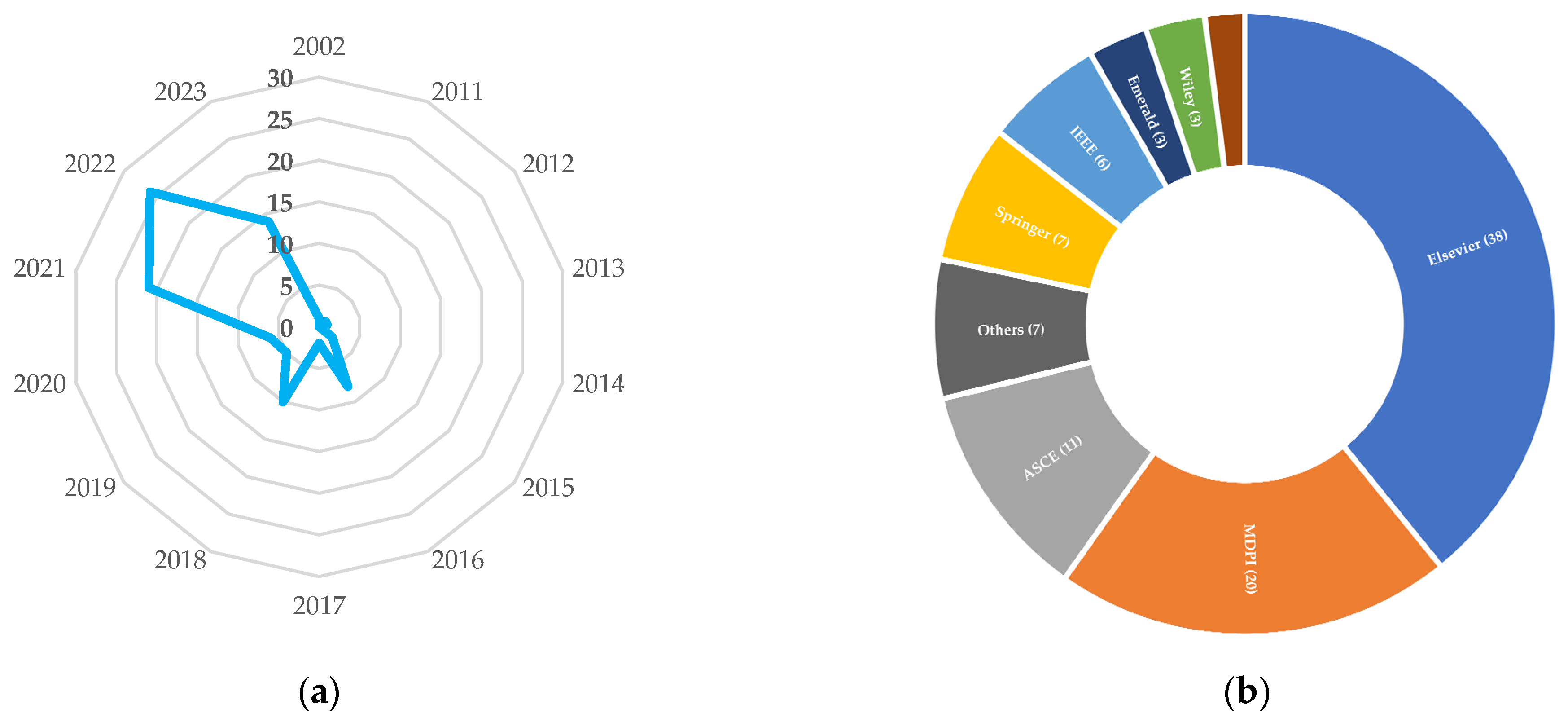

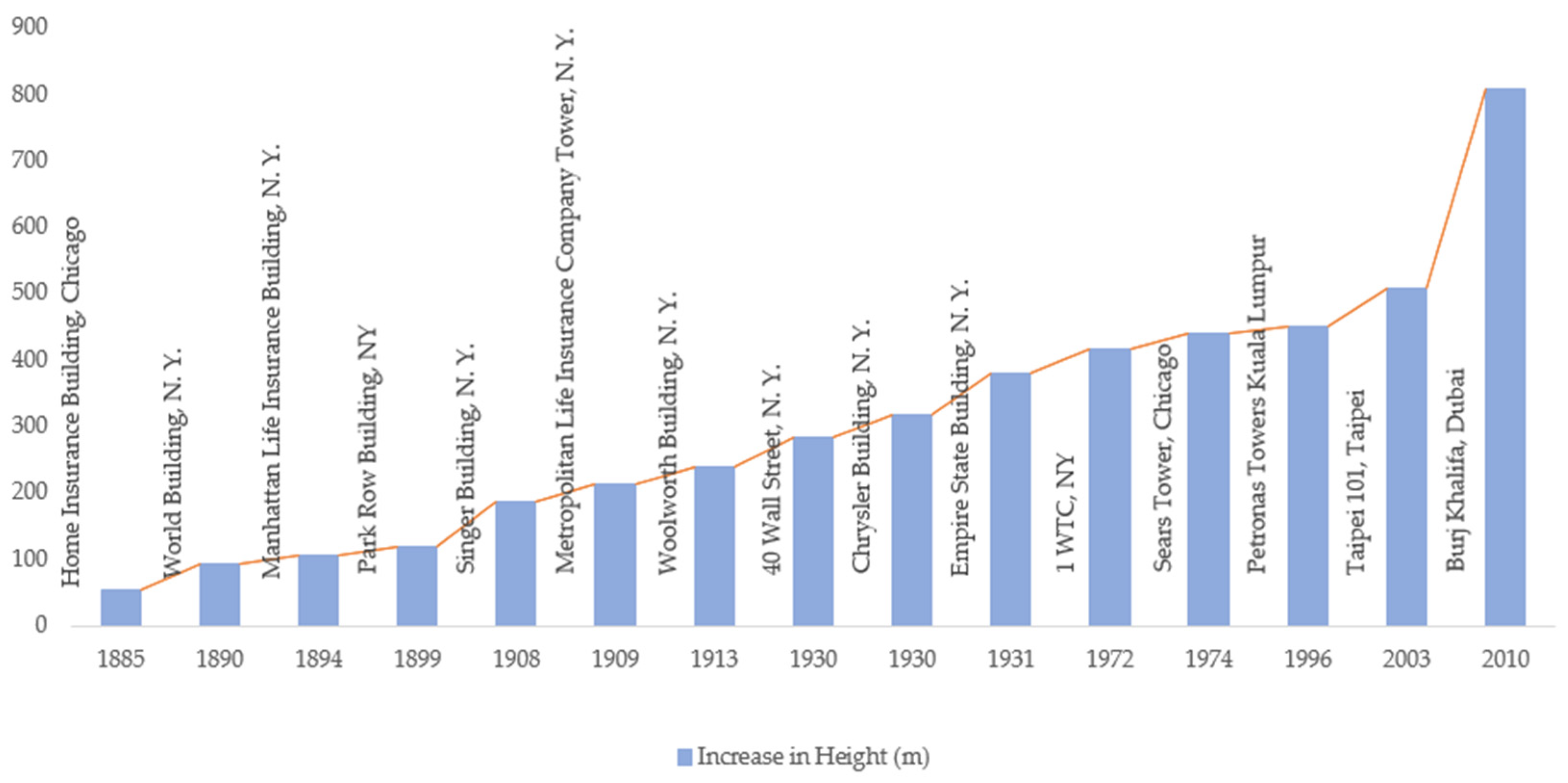
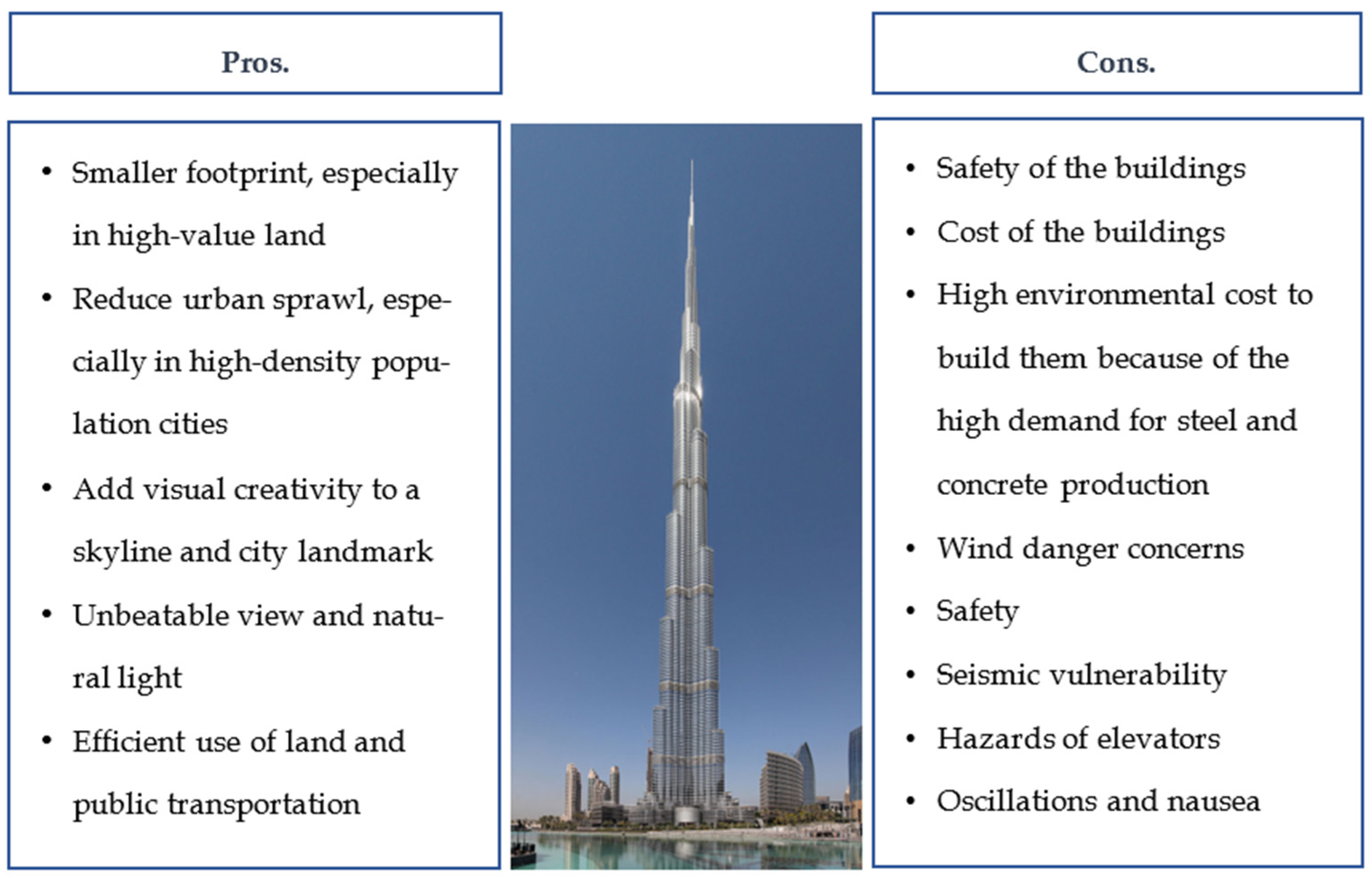
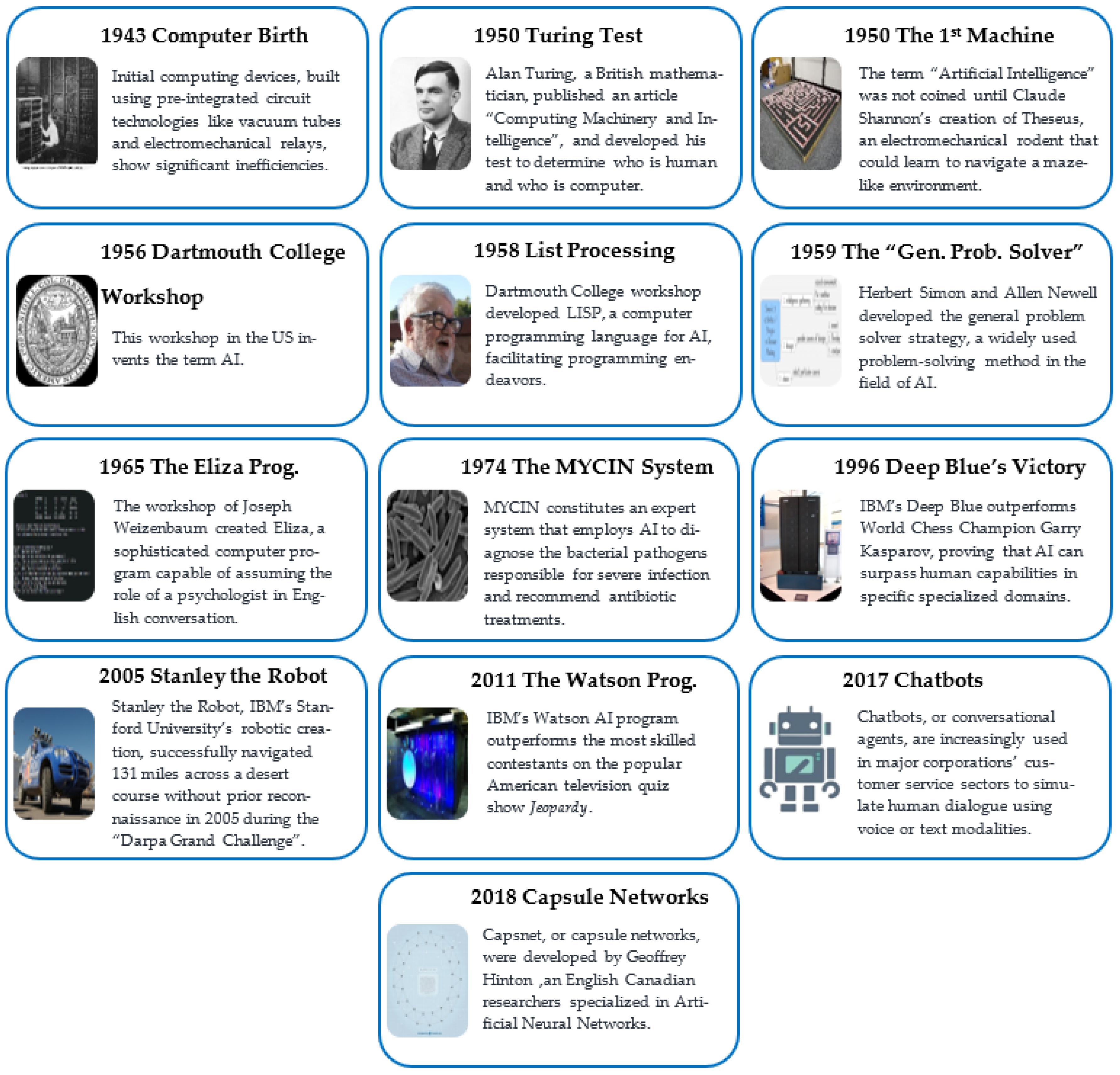
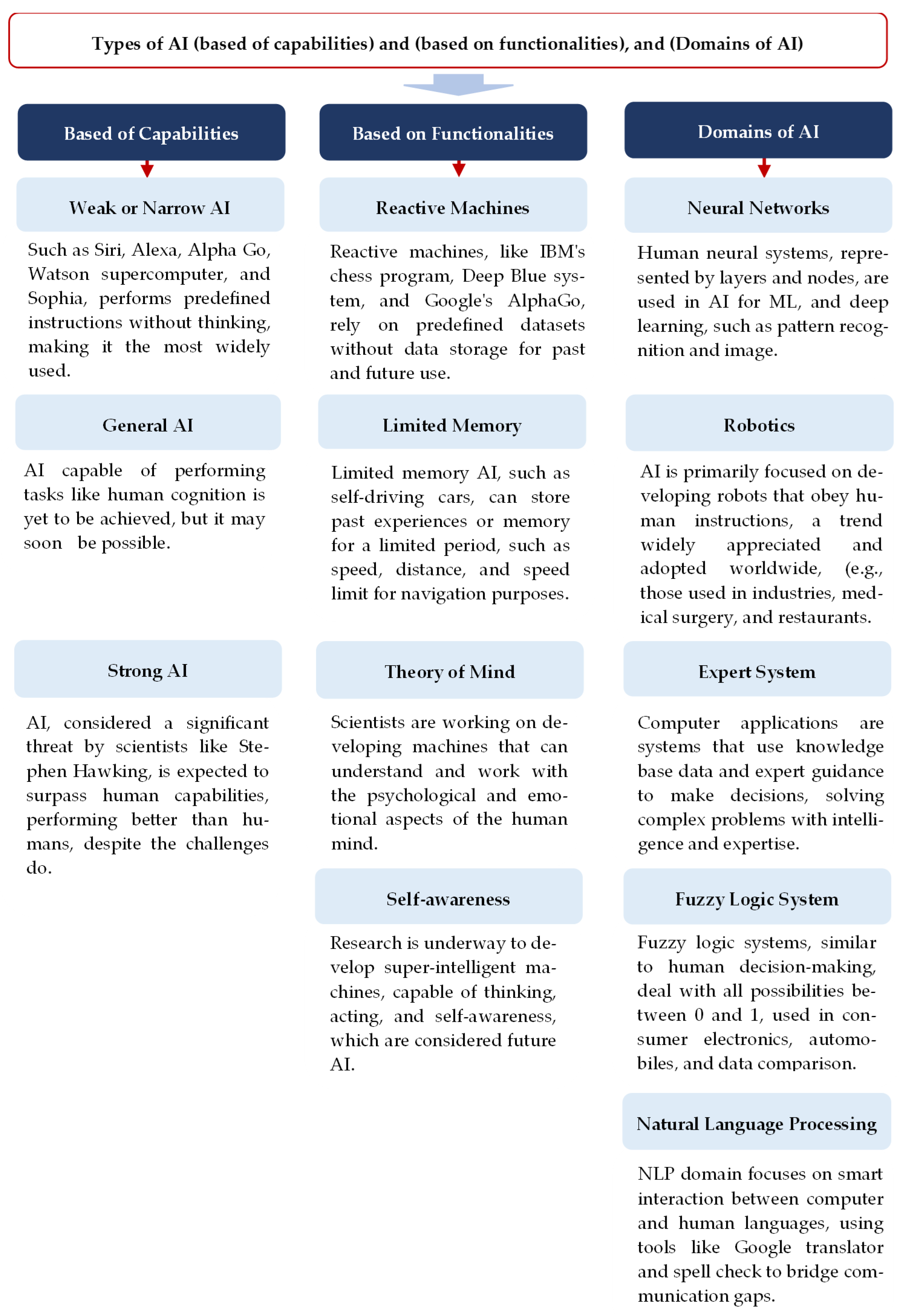


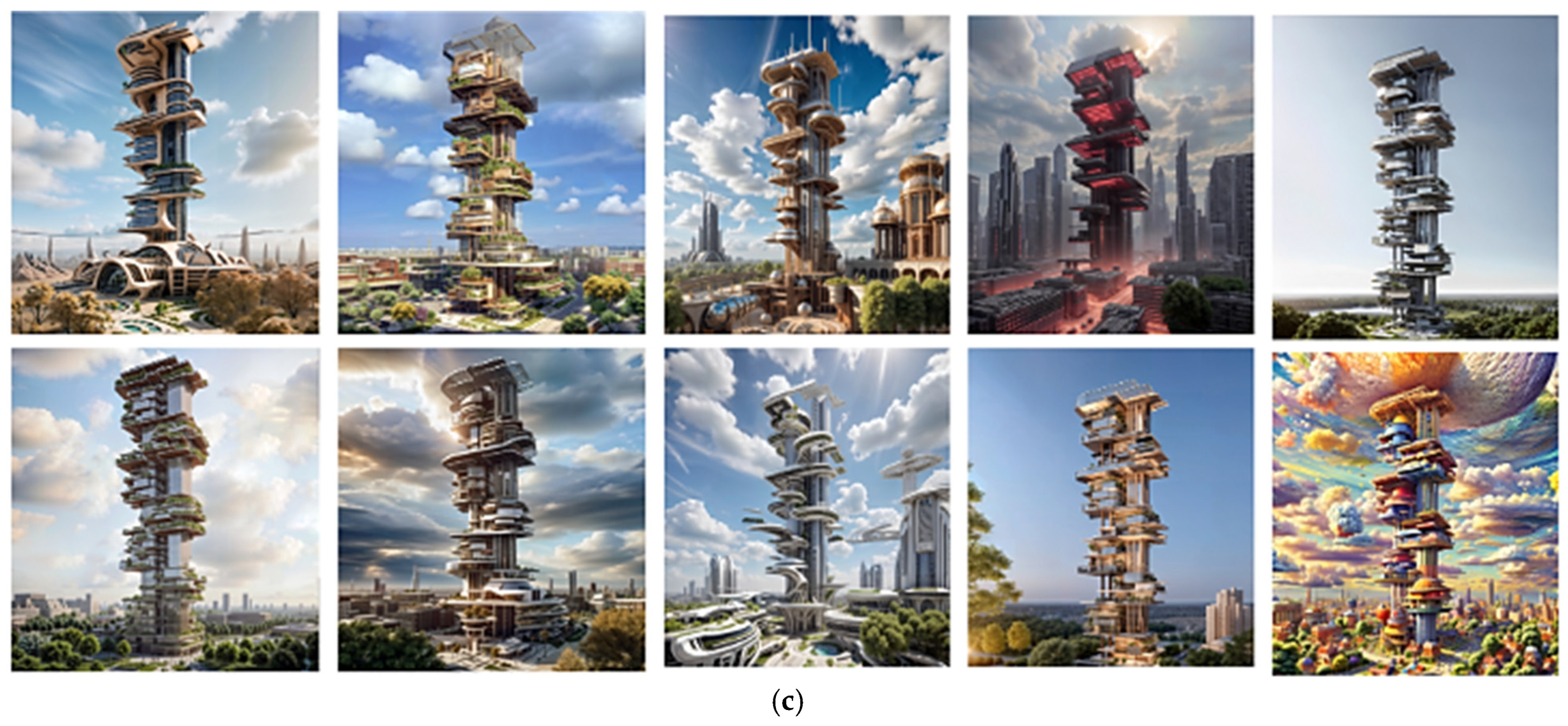
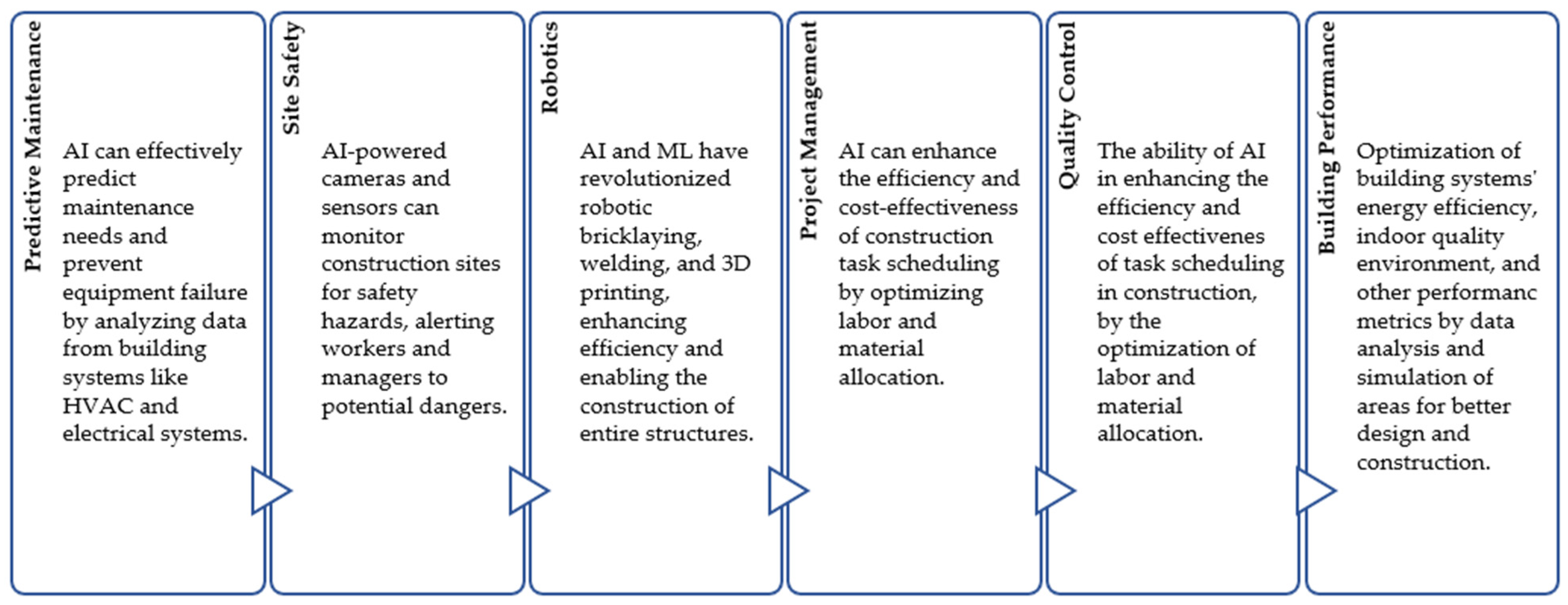
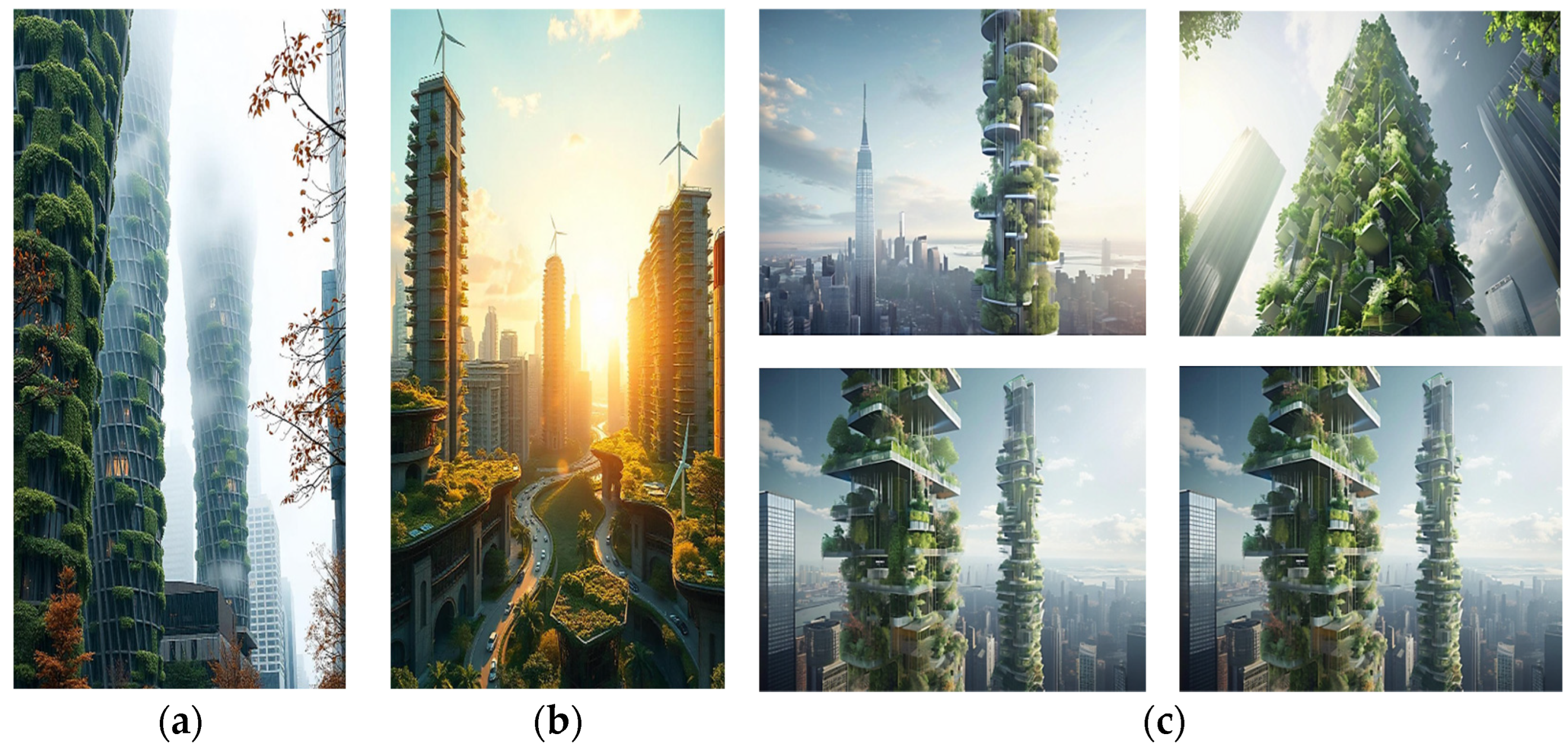

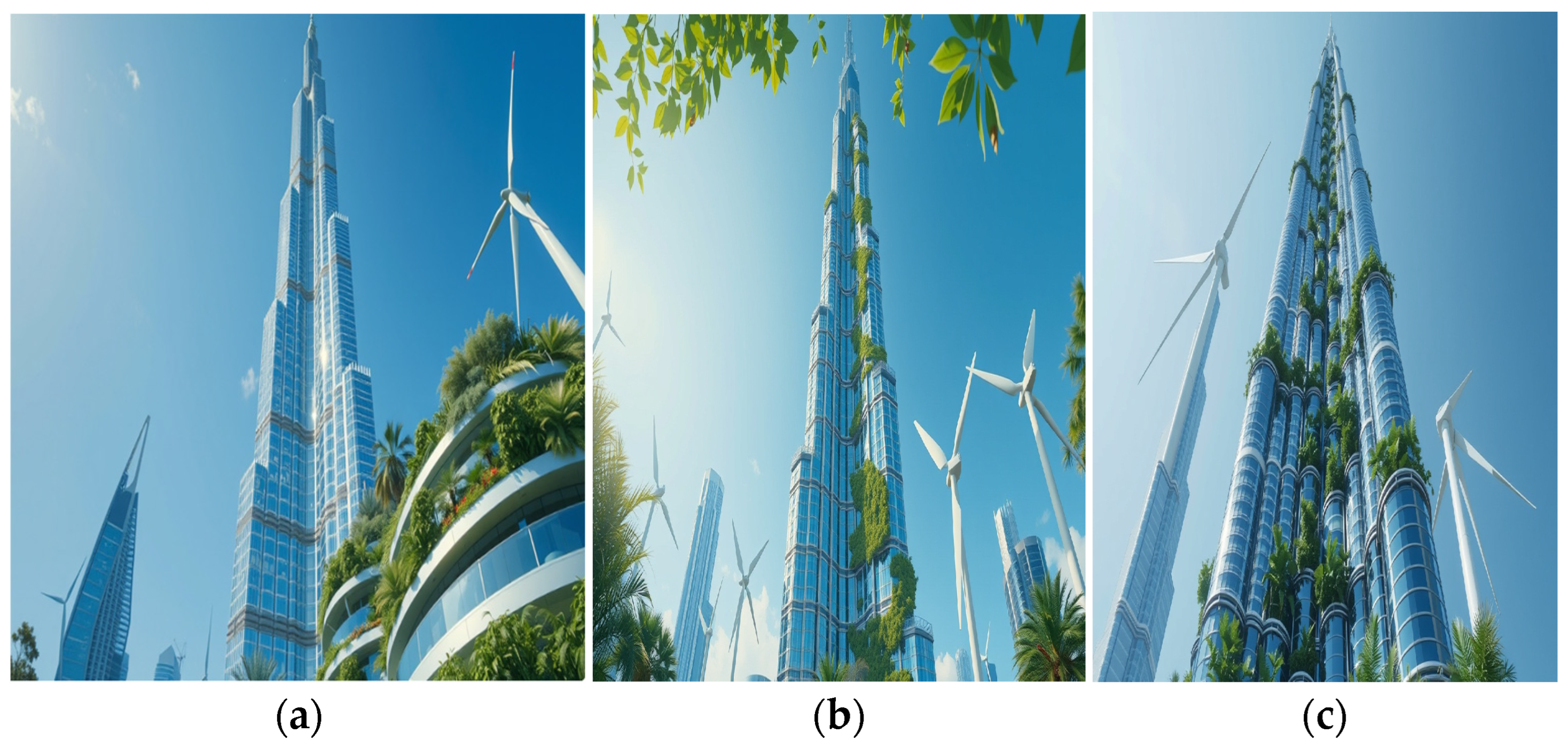


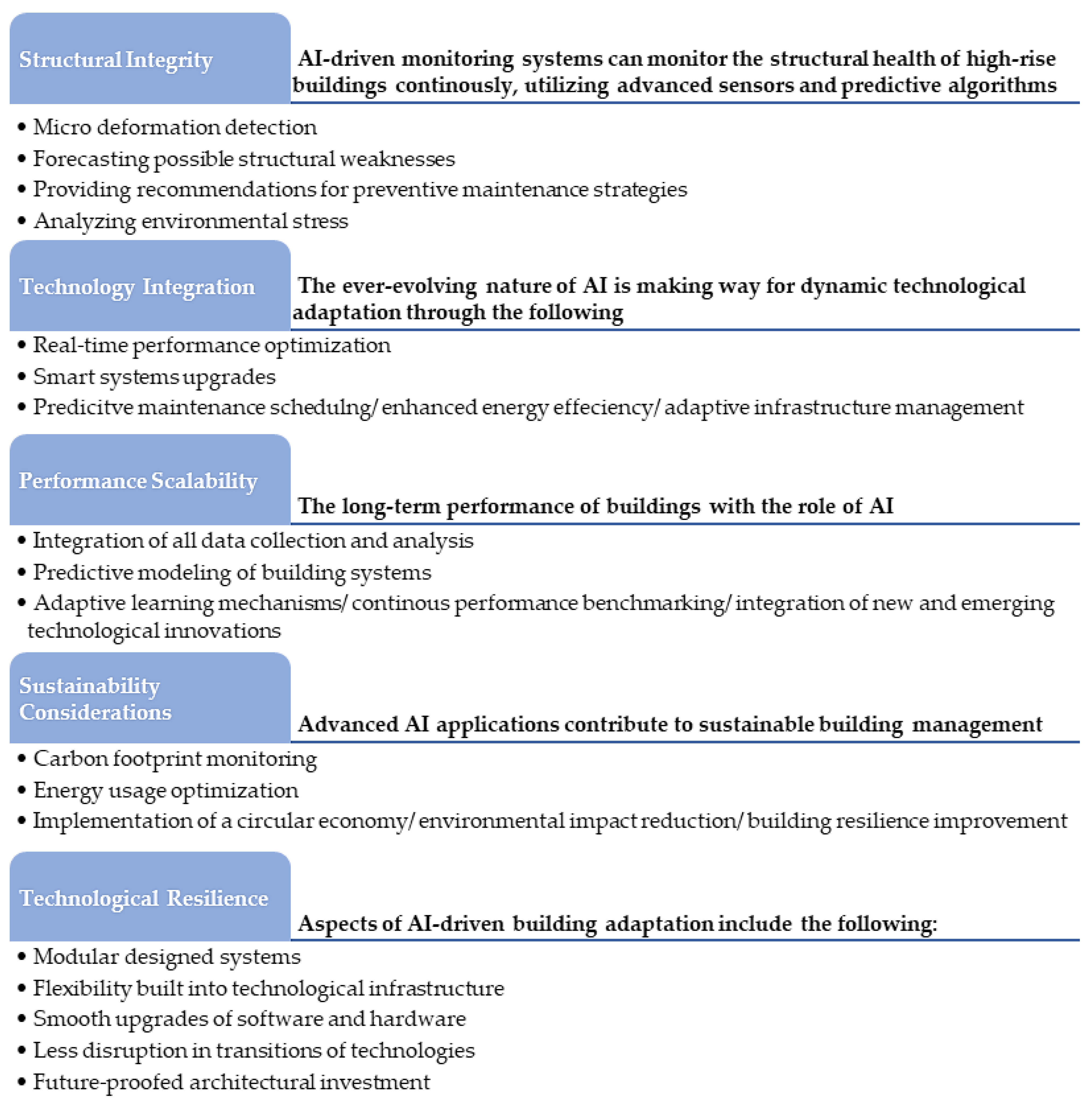

| Urban Challenges | Explanation | Utilized AI Tools | AI Tools’ Output |
|---|---|---|---|
| Smart Urban Planning | AI algorithms analyze population demographics, land use, and infrastructure data to optimize urban planning, ensuring vertical development is strategically designed for densely populated environments. | Predictive Analytics Algorithms, Geospatial ML. | Urban development simulations, optimal land use strategies, population growth predictions. |
| Dynamic Traffic Management | AI-powered traffic management systems can optimize traffic flow by utilizing real-time sensor data, reducing congestion, and improving transportation efficiency while also providing infrastructure development insights. | Adaptive Traffic Control Systems, Real-Time ML Algorithms. | Reduced traffic bottlenecks, improved transportation efficiency, dynamic signal optimization. |
| Intelligent Resource Management | AI can improve urban resource efficiency by predicting consumption patterns and optimizing resource distribution, addressing infrastructure constraints, and creating smart grids that adapt to real-time energy needs. | ML Predictive Models, Smart Grid Technologies. | Optimized resource distribution, efficient energy consumption, adaptive infrastructure planning. |
| Sustainable Design Practices | AI integration in skyscraper design can enhance sustainability by analyzing ecological impacts and optimizing energy efficiency, thereby reducing carbon emissions in urban settings. | AI-Powered Environmental Impact Assessment Tools, Generative Design Algorithms. | Reduced carbon emissions, energy-efficient building designs, sustainable urban infrastructure. |
| Community Engagement | AI enhances community engagement by analyzing resident feedback on urban projects, promoting inclusive decision-making, and promoting social equity in urban development. | Natural Language Processing, Sentiment Analysis Algorithms. | Improved community involvement, data-driven urban policy development, enhanced social equity. |
| Image | Name of the Building |
|---|---|
 | Tacoma Building, Chicago The Tacoma Building was an early skyscraper in Chicago. Completed in 1889 and constructed using a riveted iron and steel frame, the Tacoma Building was designed by the major architectural firm Holabird & Root, with theatrical details. (Image’s credit and source: Johnson, Willis Fletcher, (1857–1931), Habberton, John, (1842–1921), https://en.wikipedia.org/wiki/Tacoma_Building_%28Chicago%29 (accessed on 4 September 2024)). |
 | Rand McNally Building, Chicago The Rand McNally Building, completed in 1889, was the first skyscraper built with an all-steel frame. (Image’s credit and source: Rand McNally (1893). https://upload.wikimedia.org/wikipedia/commons/3/37/Rand_McNally_Building_1889.jpg (accessed on 4 September 2024)). |
 | The Masonic Temple Building, Chicago Featuring commercial, office, and meeting spaces, the Masonic Temple was completed in 1892. It was the tallest building in Chicago. (Image’s credit and source: Unknown author, https://commons.wikimedia.org/wiki/File:Chicago_Masonic_Temple_Building.jpg (accessed on 4 September 2024)). |
 | Tower Building, New York City The Tower Building, completed in 1889, was the first skyscraper in NY City. (Image’s credit and source:, Internet Archive Book Images, https://commons.wikimedia.org/wiki/File:A_history_of_real_estate,_building_and_architecture_in_New_York_City_during_the_last_quarter_of_a_century_(1898)_(14587355647).jpg (accessed on 4 September 2024)). |
 | New York World Building, New York City This building was home to the New York World newspaper and finished in 1890. (Image’s credit and source: George Eastman House, https://commons.wikimedia.org/wiki/File:Pulitzer_Building_(2787707752)_(cropped).jpg (accessed on 4 September 2024)). |
 | Wainwright Building (St. Louis) This skyscraper, designed by Dankmar Adler and Louis Sullivan, is famous for its terracotta facade and ornamentation; this building opened in 1891. (Image’s credit and source: w. lemay, https://commons.wikimedia.org/wiki/File:Wainwright_Building,_7th_Street_and_Chestnut_Street,_St._Louis,_MO_-_53051647915.jpg (accessed on 4 September 2024)). |
 | Flatiron Building (New York City) This is an office building designed by Daniel Burnham and Frederick P. Dinkelberg; it was completed in 1902 and originally included 20 floors with a height of 86.9 m. (Image’s credit and source: Imelenchon (original work), https://commons.wikimedia.org/wiki/File:Edificio_Fuller_(Flatiron)_en_2010_desde_el_Empire_State_crop_boxin.jpg (accessed on 4 September 2024)). |
| a. Neoclassical Revival | b. Neo-Gothic Decoration | c. Art Deco | d. The International Style | e. Contemporary and High-Tech |
|---|---|---|---|---|
 |  |  |  |  |
| The municipal building in New York City (1908–1910) (Image’s credit and source: David Shankbone, 1974. https://upload.wikimedia.org/wikipedia/commons/f/f9/Manhattan_Municipal_Building_by_David_Shankbone_edited-1.jpg (accessed on 19 February 2025)) | Metropolitan Life Insurance in New York City (1905–1909) (Image’s credit and source: Irving Underhill (1872–1960). https://upload.wikimedia.org/wikipedia/commons/6/67/Met_life_tower_crop.jpg (accessed on 19 February 2025)). | Chrysler Building in NY (1930) (Image’s credit and source: William Van Alen, Chrysler Building, New York City. Photograph, 1929. https://upload.wikimedia.org/wikipedia/commons/a/a9/Chrysler_Building%2C_NY.jpg (accessed on 19 February 2025)). | Seagram Building in NY (1956–1958) by Mies Van De Rohe and Philip Johnson | Petronas Towers in Kuala Lumpur (1996) (Image’s credit and source: Wee Honghttps://commons.wikimedia.org/wiki/File:Petronas_Twin_Towers_(230715-1406).jpg (accessed on 10 October 2024)). |
 |  |  |  | |
| Woolworth Building by Cass Gilbert (1913) (Image’s credit and source: Copyright by The Pictorial News Co., N.Y. No. NN 98, https://commons.wikimedia.org/wiki/File:View_of_Woolworth_Building_fixed.jpg (accessed on 19 February 2025)). | The Empire State Building in NY (1931) (Image’s credit and source: Commons, https://upload.wikimedia.org/wikipedia/commons/f/f1/Empire_Estate.jpg (accessed on 19 February 2025)). | The Lake Shore Drive Apartments in Chicago (1951). (Image’s credit and source: User:JeremyA, https://commons.wikimedia.org/wiki/File:860-880_Lake_Shore_Drive.jpg (accessed on 19 February 2025)). | Taipei 101 in Taipei (2003) (Image’s credit and source: AngMoKio, https://commons.wikimedia.org/wiki/File:Taipei_101_2009_amk-EditMylius.jpg (accessed on 19 February 2025)). | |
 |  |  | ||
| The RCA Building in NY (1933) (Image’s credit and source: D. Benjamin Miller, https://en.wikipedia.org/wiki/30_Rockefeller_Plaza#/media/File:Rockefeller_Center,_December_1933.jpg (accessed on 19 February 2025)). | World Trade Center in NY (1972) (Image’s credit and source: Jeffmock, https://commons.wikimedia.org/wiki/File:World_Trade_Center,_New_York_City_-_aerial_view_(March_2001).jpg (accessed on 10 October 2024)). | Burj Khalifa in Dubai (2010) (Image’s credit and source: Donaldytong, https://en.wikipedia.org/wiki/File:Burj_Khalifa.jpg (accessed on 10 October 2024)). | ||
 Sears Tower in Chicago (1973) (Image’s credit and source: Daniel Schwen, https://commons.wikimedia.org/wiki/File:Chicago_Sears_Tower.jpg (accessed on 19 February 2025)). |
| Strategy | Explanation |
|---|---|
| Iterative Feedback Loops | Integrating iterative design processes in which users can continuously provide feedback may help refine AI outputs. The designer will thus be able to dynamically adjust functional requirements according to user insights and aesthetic preferences. |
| Keyword Optimization | While writing the prompt, the refinement of the keywords should be selected carefully to enhance the quality of the AI-generated outputs. Keywords should encompass both functional aspects (e.g., “durable”, “sustainable”) and aesthetic qualities (e.g., “modern”, “cultural”) to guide the AI effectively. |
| Functional Prototyping | Such as 3D printing or digital prototypes of AI-generated designs, which can help assess their functionality. This step allows for testing aspects like usability, accessibility, and compliance with building codes. |
| Multidisciplinary Collaboration | In the design processes, the cooperation of engineers, architects, and AI specialists ensures that both functional and aesthetic criteria are met. Additionally, it fulfills the gap between technical requirements and creative vision. |
| Cultural Contextualization | Training the systems with datasets from the local architectural style and cultural significance contributes to having designs that resonate with the community’s identity and heritage. |
| Regulatory Compliance Checks | Acquiescence checks for local building codes and regulations in the AI design process can ensure that the output will not only be aesthetically pleasing but also legally viable. |
| User-Centered Design Approaches | To find solutions that are both functional and visually appealing, the users’ needs should be a priority in the design processes. |
| Advanced Visualization | Technologies such as Virtual Reality (VR) and Augmented Reality (AR) let stakeholders experience AI-generated designs in realistic settings. |
| Feedback from Design Workshops | The designers who utilize AI in their design should conduct workshops to give a rich discussion about the design outputs, to give a profound understanding of how well AI meets functional and aesthetic expectations. |
| Continuous Learning Algorithms Are Used in ML | The adaptation of ML algorithms is implemented based on the user input and its interaction and preferences; this leads to improvements in the AI’s abilities and generates designs that meet both functional and aesthetic requirements. |
| Building’s Image | Building’s Name and Description | Building’s Image | Building’s Name and Description |
|---|---|---|---|
 |
|  |
|
 |
|  |
|
 |
|  |
|
 |
|  |
|
 |
|  |
|
| Environmental Aspects | Description |
|---|---|
| Habitat assessment and resource conservation | AI and Building Information Modeling tools enable architects and engineers to analyze data, create designs, and predict risks. They manage repetitive tasks, reduce errors, and reduce costs. AI also helps detect collisions, improving quality and reducing rework. This integration results in significant time and resource savings compared to conventional methods. |
| Biodiversity assessment and species identification | AI algorithms in construction projects develop predictive analytics from data to predict which problems will most likely occur and what corrective measures are required. This will contribute to better machine lifetimes, a reduction in downtime, improvements in project planning and decision-making, and assurance of worker safety. |
| Natural disaster prediction and early warning systems | It revolutionizes monitoring at the construction project through the real-time processing of big data, hence the ability to identify any bottlenecks by the teams and their undertaking of corrective measures. It improves resource management by identifying material and labor shortages, time theft, and resource wastage. |
| AI’s Constraints on Generated Images | Analysis | |
|---|---|---|
| High initial investment | Significant initial investments in AI technologies hinder adoption by smaller firms. | |
| Data quality and availability | AI systems necessitate comprehensive datasets; incomplete data may result in flawed outcomes. | |
| Technical integration complexity | Integration of AI tools with existing systems poses considerable challenges. | |
| Computational limitations | Such complicated generative designs and simulations require much computational power, increasing processing time and energy consumption. | |
| Algorithmic bias | With this kind of training data brought into the equation, inherent biases will be created, which could realign design outcomes and redefine cultural dynamics. | |
| Skill gap and training | There is a glaring deficiency in the number of persons trained in architecture, AI, and computational methods. | |
| Regulatory and compliance challenges | Current building regulations and codes do not adequately apply to AI-assisted design processes. | |
| Creative intuition constraints | The ability of AI to imitate human creativity and contextual knowledge is narrow. | |
| Cybersecurity risks | AI systems can be prone to data contravention and benignity problems. | |
| Ethical and accountability issues | Liability and accountability of AI-generated design recommendations are still a mystery. | |
| Over-reliance on technology | It brings down the human skill and critical thinking in architectural design. | |
| Performance variability | Its performance varies depending on the type and complexity of the projects. | |
| Limited contextual understanding | Complex site conditions and cultural contexts are then hard for AI to fathom. | |
| Maintenance and update costs | AI systems also needs continued investment just to maintain and update them with design improvements. | |
| Interdisciplinary collaboration challenges | It will require close collaboration among architects, engineers, AI experts, and stakeholders. | |
| Constraints related to generated images | Restricted customization and control | Most architecture professionals seem intrigued and shocked by the NLP-driven AI file generator for producing text-based images, different from the conceptually more traditional modeling in a parametric design world. This textual approach nevertheless limits control over the architectural image and further refinement in other tools. |
| Ignorance about the viability of the structural design | AI image generators may be biased towards complex objects due to their extensive dataset and lack of structural integrity or realism metrics, potentially resulting in models that may not accurately represent reality or construction feasibility. | |
| Results that are inconsistent | Spanish artist David Romero uses AI’s text-generated image-making technologies in architectural projects, but inconsistent designs may result from varying stylistic components. | |
| Technical Difficulty | Specific Challenges | Proposed Solutions |
|---|---|---|
| Data Compatibility | Heterogeneous data formats, inconsistent data quality, legacy system constraints | Implement robust ETL (Extract, Transform, Load) processes, develop universal data adapters, use data normalization techniques |
| Computational Infrastructure | Limited computational resources, high processing requirements, scalability issues | Utilize cloud-based AI infrastructure, implement distributed computing frameworks, leverage containerization technologies |
| Model Interpretability | Black-box AI models, lack of transparency, difficulty in explaining AI decisions | Develop explainable AI (XAI) frameworks, use interpretable ML techniques, implement model monitoring tools |
| Security and Privacy | Data breaches, model vulnerability, regulatory compliance | Implement advanced encryption, develop robust authentication mechanisms, and create AI-specific cybersecurity protocols |
| Integration Complexity | Diverse technological ecosystems, API limitations, system interdependencies | Design flexible micro-services architecture, develop comprehensive integration middleware, and create standardized AI integration protocols. |
| Climate Type | AI Application | AI Tools/Technologies |
|---|---|---|
| Cold Climate | AI can optimize designs for EE in heating and insulation. ML algorithms can analyze historical weather patterns to improve building resilience against snow loads and thermal performance. |
|
| Hot Climate | In hot climates, AI can design buildings that maximize natural ventilation and minimize solar heat gain. Generative design algorithms can explore various shading strategies and cooling solutions. |
|
| Humid Climate | Managing humidity levels through smart HVAC systems that adapt to indoor and outdoor conditions, improving comfort and preventing mold growth. |
|
| Windy Areas | AI can optimize the aerodynamic shape of buildings to mitigate wind loads. Additionally, it can be used in the design of wind-resistant structures and the placement of openings to harness natural ventilation. |
|
| Building’s Name | Location | AI and EE Features | Used AI Tools |
|---|---|---|---|
| The Edge | Amsterdam, the Netherlands |
|
|
| Salesforce Tower | San Francisco, USA |
|
|
| One Angel Square | Manchester, UK |
|
|
| Shanghai Tower | Shanghai, China |
|
|
| Apple park | Cupertino, USA |
|
|
| Aspect | Key Comparative Points | AI-Enhanced Skyscrapers | Traditional Skyscrapers |
|---|---|---|---|
| Energy consumption and Analysis | AI-optimized HVAC systems Smart energy management Predictive consumption pattern/Automated adjustment to occupancy [99] | HVAC schedules/Manual energy management/Standard consumption monitoring/Preset operation patterns | |
| Material usage | AI-optimized material selection/Waste prediction and prevention/Smart inventory management/Precise materials calculations [100] | Traditional material selection/Standard waste management/Manual inventory tracking/Estimated material needs | |
| Environmental impact | Sustainability assessment | Real-time data-driven analysis | Manual time-consuming methods |
| Resource management | AI-optimized allocation/Detailed lifecycle analysis | Manual scheduling | |
| Environmental Impact | Detailed lifecycle analysis | Basic assessment | |
| Carbon footprint | Real-time emission monitoring/AI-driven carbon reduction/Optimized construction processes/Smart transportation logistics [101] | Periodic emissions checks/Standard reduction methods/Traditional construction flow/Regular logistic planning | |
| Planning and construction speed | Data-driven optimization/Automated progress tracking/Real-time adjustment | Experience-based | |
| Resource management | AI resources allocation/Predictive budgeting/Automated cost optimization/Dynamic pricing models. | Manual resource planning/Standard ordering/Physical tracking/Fixed allocation | |
| Cost efficiency | Real-time cost tracking/Predictive budgeting/Automated cost optimization/Dynamic pricing models | Periodic cost review/Traditional budgeting/Manual cost control/Fixed pricing structures | |
| Design speed | Rapid, iterative generation | Slow, linear process | |
| Optimization | Comprehensive multi-parameter optimization | Limited computational analysis | |
| Efficiency | Design variation | Thousands of algorithmic variations | Few manual iterations |
| Predictive capabilities | Advanced predictive modeling | Minimal | |
| Error detection | Automated real-time detection | Manual inspection | |
| Structural analysis | Dynamic performance modeling | Static calculations | |
| Construction monitoring | Automated monitoring systems | Manual supervision | |
| Design flexibility | Real-time adaptability | Limited modifications | |
| Cost prediction | ML prediction | Based on historical data | |
| Material selection | Data-driven optimization | Experience-based choice | |
| Documentation | Automated documentation | Manual documentation | |
| Occupants’ comfort | Personalized optimization/AI-driven environmental control/Real-time air quality management/Smart lighting systems | Standard climate control/Fixed space layout/Periodic air quality check/Traditional lighting | |
| Human-centric performance | Safety and security | Real-time safety monitoring/Predictive smart access control/Risk assessment/Automated emergency response. | Standard safety protocols/Regular risk assessment/Manual emergency systems/ |
| Maintenance and operation | Predictive, preventive, real-time performance tracking/AI-driven facility management | Reactive, scheduled/Manual facility management/Standard system operations/Periodic performance check | |
| Risk assessment | Comprehensive predictive analysis | limited scope | |
| Space utilization | AI-optimized speed planning | Standard metrics | |
| Safety planning | AI-enhanced risk mitigation | Standard protocols | |
| Building longevity | Predictive structural health/AI optimized lifecycle/Smart material aging analysis/Continuous adaptation | Regular structural checks/Standard lifecycle planning/Traditional aging assessment/Fixed system. | |
| Long-term impact | Future adaptability | AI-enabled flexibility/Smart space configuration/Automated upgrades/Progressive optimization | Fixed infrastructure/Manual configuration/Traditional upgrades/Standard optimization |
| Building performance | Adaptive and learning systems | Fixed systems | |
| Quality control | AI-powered monitoring | Human inspection |
| Advantages | Disadvantages |
|---|---|
| Design Optimization Rapid design generation, enhanced structure efficiency, and improved space usage. | Creative Limitations It may lack human intuition and creativity, with risk-standardized solutions and a potential loss of architectural uniqueness. |
| Efficiency and Speed Faster design processes reduce human error and accelerated decision-making. | Technical Challenges High initial implementation costs, complex integration with existing systems, and need for specialized training. |
| Cost Benefits Reduced design costs, optimized material usage, and better cost prediction. | Dependency Risks Over-reliance on technology, system failures could halt work, and high maintenance costs. |
| Sustainability Enhanced energy efficiency, improved environmental performance, and better resource management. | Human Factor Reduced human involvement, potential job displacement, and loss of traditional skills. |
| Data Management Better information integration, enhanced collaboration, and improved documentation. | Data concerns Data privacy issues, security vulnerabilities, and data accuracy dependence. |
| Performance Analysis Advanced simulation capabilities, real-time performance monitoring, and predictive maintenance. | Implementation Challenges High learning curve, resistance to change, and integration with existing workflows. |
| Safety and Risk Management Enhanced safety analysis, better risk prediction, and improved emergency responses. | Ethical Considerations Accountability issues, professional responsibility questions, and decision-making transparency. |
| Project Management Better resource allocation, improved scheduling, and enhanced coordination | Regulatory Challenges Unclear regulatory frameworks, compliance issues, and liability concerns. |
| Innovation Potential New design possibilities, advanced material solutions, and new structural approaches. | Technological Limitations Current AI capabilities’ limits, processing power requirements, and software compatibility issues. |
| Long-Term Benefits Improved building lifecycle management, better maintenance prediction, and enhanced adaptability. | Long-term Concerns System obsolescence, long-term reliability unknown, and future compatibility issues. |
Disclaimer/Publisher’s Note: The statements, opinions and data contained in all publications are solely those of the individual author(s) and contributor(s) and not of MDPI and/or the editor(s). MDPI and/or the editor(s) disclaim responsibility for any injury to people or property resulting from any ideas, methods, instructions or products referred to in the content. |
© 2025 by the authors. Licensee MDPI, Basel, Switzerland. This article is an open access article distributed under the terms and conditions of the Creative Commons Attribution (CC BY) license (https://creativecommons.org/licenses/by/4.0/).
Share and Cite
Emad, S.; Aboulnaga, M.; Wanas, A.; Abouaiana, A. The Role of Artificial Intelligence in Developing the Tall Buildings of Tomorrow. Buildings 2025, 15, 749. https://doi.org/10.3390/buildings15050749
Emad S, Aboulnaga M, Wanas A, Abouaiana A. The Role of Artificial Intelligence in Developing the Tall Buildings of Tomorrow. Buildings. 2025; 15(5):749. https://doi.org/10.3390/buildings15050749
Chicago/Turabian StyleEmad, Samaa, Mohsen Aboulnaga, Ayman Wanas, and Ahmed Abouaiana. 2025. "The Role of Artificial Intelligence in Developing the Tall Buildings of Tomorrow" Buildings 15, no. 5: 749. https://doi.org/10.3390/buildings15050749
APA StyleEmad, S., Aboulnaga, M., Wanas, A., & Abouaiana, A. (2025). The Role of Artificial Intelligence in Developing the Tall Buildings of Tomorrow. Buildings, 15(5), 749. https://doi.org/10.3390/buildings15050749








